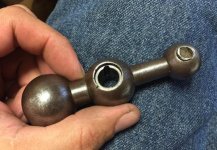anchorman
Titanium
- Joined
- Dec 19, 2005
- Location
- Opelika, AL
repairing broken cross feed handle on 1941 SB 13" lathe
Any tips on repair for this? I've been dealing with it being broken for years, but I need it fixed now. I can't find a new one for an affordable price if at all.
I was going to put it in the mill and try to drill out the stub of the broken off handle, but am not sure what the preferred method is for installing a new handle in there. Were the originals press fit, or brazed in place? doesn't seem like these were screwed together.

Any tips on repair for this? I've been dealing with it being broken for years, but I need it fixed now. I can't find a new one for an affordable price if at all.
I was going to put it in the mill and try to drill out the stub of the broken off handle, but am not sure what the preferred method is for installing a new handle in there. Were the originals press fit, or brazed in place? doesn't seem like these were screwed together.

Last edited:


